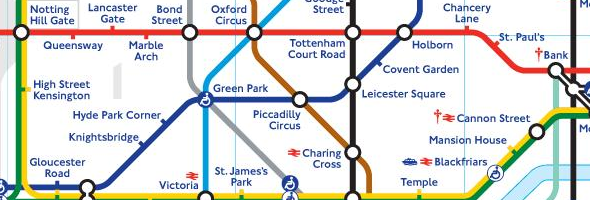3 things the London underground map can teach you about marketing content

Harry Beck’s 1933 London underground map is considered a design classic. Despite many attempts at improvements, the map has largely remained unchanged throughout the years and is considered one the best graphic designs coming out of the UK.
At the time, however, the London map was considered revolutionary. Earlier map versions had literal representations of distances but were complicated and difficult to follow. Beck realized it was unnecessary for a map of an underground train to be cluttered with street names and surface geography. Accuracy of distances and physical location of stations were also unimportant. What mattered most was for the map to help the traveler get around – know which station came after which station, and where lines connected with one another. All other details simply created unnecessary noise.

This is Beck’s original 1933 map. Ignores geographical accuracy and instead only communicates data
needed by passengers. Marketing content should do the same.
Seems almost trivial these days, doesn’t it? But perhaps it’s worth applying some of these common-sense principles to your own marketing communications:
1- It’s what matters most to your prospect that counts.Check each piece of communication – web page, white paper, presentation – and see whether it focuses on your prospects’ problems, point of view, and tasks, or is it centered around your product/technology instead.
2- Subtract your pitch points. Remove any piece of data that isn’t absolutely necessary to achieve the goal of the specific marketing tool. Are the detailed descriptions your technology needed at this specific stage of the sales cycle? Remember that each marketing piece should have a specific goal that’s related to the stage of the sales cycle. Don’t pour all your content just because it’s available. Check that your communication is uncluttered and functional.
3- Be different. Beck’s map was initially turned down with the argument that it was too revolutionary — “It wouldn’t mean anything to anybody.” In the high-tech world, executives are always innovative about technology. Less so when it comes to marketing and communications. Don’t listen. Harry Beck’s map was printed in a trial edition of 500 copies without much faith. All copies were devoured and second edition was immediately printed. Then a third, and here we are today, 80 years later with almost the identical map.
Regardless of the above, take a look at this wonderful story of the London underground map.